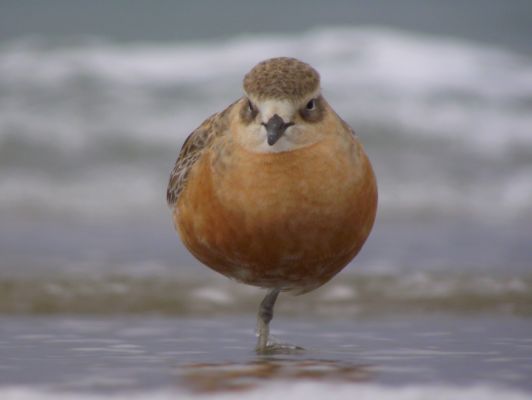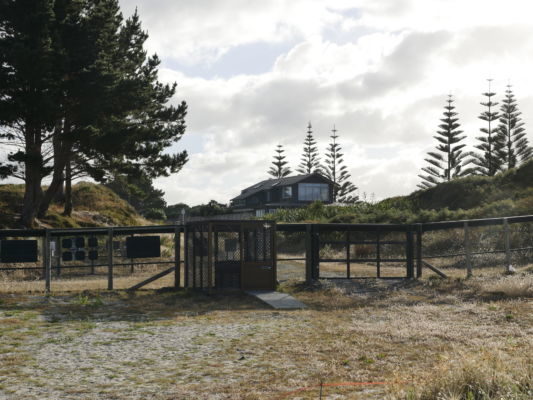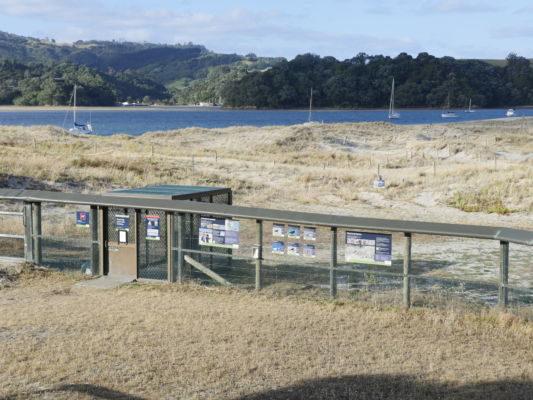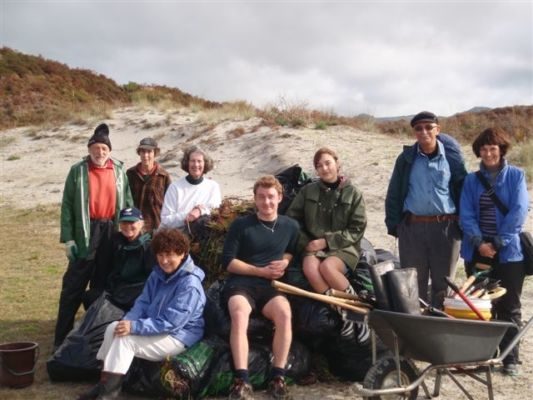Fondly referred to by some as ‘Dots’, New Zealand dotterels are appealing little shore birds, their sharp ‘cheep’ call signalling their constant alertness to possible danger. They need to be watchful. Dotterels nest on the ground, where the camouflage of their colouring gives some protection against aerial predators but not against mammals. Camouflage isn’t much of an obstacle to predators with a strong sense of smell.
Note: We are re-sharing our articles. This article was originally published on January 22, 2017.

The NZ dotterel is endemic to New Zealand and their numbers are threatened and yet they often live and breed in close proximity to human communities. On Omaha Spit in Rodney District, north of Auckland, David Stone, a trustee of the Omaha Shorebird Protection Trust, estimates that the closest housing is now only about 80 metres away from the Shorebird Sanctuary. That’s close – very close! Sections in the adjacent subdivision have been sold and there is constant building activity.
Those new houses are one of several subdivisions that have been developed in recent years. Omaha has a modest but growing population of permanent residents, as well large numbers of holiday home owners, holiday home renters and day visitors who flock to Omaha at holiday times.
“It goes from 1200 people up to 10,000 in summer,” David estimates.
The Omaha Sanctuary is also a flocking site for dotterels. Birds in the region gather there in the autumn after the breeding season. While many move on to nest elsewhere, about 19 pairs stay. Since the Sanctuary was created by the erection of a pest proof fence in 2012, the number of fledged chicks has gradually increased. The Sanctuary can now be regarded as a successful breeding site, as long as the current success can be maintained for at least five years.

Breeding success is measured as the ratio of number of fledged chicks to number of breeding pairs. A ratio of 1:2 means the local population is sustainable if maintained for 5-10 years. Statistics on post-breeding flock numbers and annual breeding success can be viewed here.
The Omaha Sanctuary is a ‘managed’ site, meaning that the dotterels will survive only with constant and ongoing pest control. In 1993 local residents led by Laura and Jim McKinlay began trapping predators. They put up simple tape fences to protect nests, which are simple scrapes in the sand, from human disturbance. Sometime after the death of Laura Jim was awarded an Old Blue, Forest and Birds’ highest honour for his (and Laura’s) efforts over many years. The Omaha Shorebird Protection Trust continues the protection programme of all the shorebirds at Omaha and particularly the NZ dotterel.
“Conventional pest management alone was not working. The threats had increased as the subdivision grew. The influx of holidaymakers, often with their cats and dogs, during the summer months coincided with the shorebird nesting season. The imminent development of the remaining sections adjacent to the Sanctuary would result in increased predation and disturbance” observes David.

After a public meeting in 2009 convened to reignite local involvement in the continued protection and preservation of all shorebirds on the Omaha Spit the Omaha Shorebird Protection Trust was created in early 2010. The Trust also had the intended purpose of fund raising for a pest proof fence and co-ordinating future pest management of the principal shorebird breeding sites at the tip (northern end) of the Spit.
“Drawing on experience elsewhere the Trust determined a pest proof fence was the best solution and Rodney District Council provided $10,000 seed funding” David explains “ An intensive fund-raising campaign followed –well supported by individuals local and from further away, the two local residents organisations, charitable funders and also by donations from many family-based conservation trusts and not all of them Auckland-based. The ASB Community Trust (now Foundation North) made a major contribution and Auckland Council joined in too.
The target of $168,000 was achieved in ten months.”With funding secured a Resource Consent was applied for and granted and the Xcluder fence was built over the winter of 2012.
The Omaha Sanctuary is within North Omaha Reserve administered by now Auckland Council. The 387m long fence protects an area of about 3 ha. The fence starts along the southern ocean groyne and extends across the spit to the high tide mark at the estuary end.
Rats, stoats, weasels and hedgehogs all threaten the ground-nesting dotterels. Rabbits need to be kept in check because they attract predators. Currently there are over 40 DOC 200 predator traps and a number of ‘rat motels’ and mice ‘hotels’ – the latter two intended as ‘one night stands’ – mostly outside the fence. They are checked every few days by volunteers. Sixteen Rat bait stations near the two ends of the sanctuary are checked weekly. Trapping statistics to date can be viewed HERE.

A trail camera at the estuary end of the sanctuary regularly detects nocturnal incursions by cats at low tides Cats – both feral and domestic – are a problem. This breeding season already 2 dotterel chicks have been killed. Because well-loved pets may wander from the nearby housing subdivisions, only live-trapping of cats is carried out and cats are seldom caught as cats are usually cage shy. Dogs are a problem too despite the whole of the Reserve and the sanctuary being a “No Dogs” area.
As well as pest management the Trust conducts restoration planting mostly of sand binding plants such as spinifex and pingao and native back-dune plants, weed eradication, shorebird monitoring and education by way of comprehensive signage at the two gates to the Sanctuary (one at each end of the fence), brochures, direct contact with visitors to the Sanctuary and a website.
According to David the Trust has planning underway to solve the ‘leaky’ fence end problem, namely to extend the fence at the estuary end to the low tide mark. “It’s a much more complex issue – both in terms of design, engineering, construction and necessary Consents. While such an extension into the tidal zone couldn’t happen in many situations, the particular geography of Omaha Spit means there are several possible solutions that can be considered”, comments David.
“It could be a floating ‘pontoon’ fence similar to marinas,” says David, “or a fixed fence into the sand or a rock groyne with a fence on top.”
While such a solution, in conjunction with continuing trapping, will deal to mammalian predators, aerial predation, mostly black-backed gulls and occasionally harrier hawks remains a problem at Omaha.
Dotterels will chase the invaders in the air, but can’t always save their chicks. The variable oystercatchers which also nest in the Omaha Sanctuary are more aggressive and effective at warding off such predators. The Trust’s website has a video which includes grim but stunning footage of just how quickly a black-backed gull can gulp down three newly hatched dotterel chicks.
In addition natural predators the shorebirds must contend with human disturbance because the Omaha Sanctuary is on public land, it is also popular with walkers and joggers and the end of the Spit that is within the Sanctuary is a popular fishing spot.
Advocacy is, therefore, another important part of the Trust’s work, educating and encouraging a better understanding of the needs of and threats to the vulnerable shore birds and migratory birds on Omaha beach. The public has access to the fenced sanctuary, and signs encourage awareness of nesting birds and tape fences indicate no-go areas where nests are known to be located.

Locals are supportive and take part in restoration planting initiatives in North Omaha Reserve, including the Sanctuary.
“The residents and ratepayers Omaha Beach Community organisation has been very supportive of the Sanctuary project from the beginning,” David says. “And now the success of the fenced sanctuary is inspiring Omaha residents to look at their own predator control. The exciting prospect that Omaha itself could be predator free is a proposal that will be discussed soon at the annual planning forum of the Community group”.
Access to Omaha is via a causeway, so the local geography provides a ‘defensible border’ that makes it particularly suitable to becoming predator free. Extending the border of predator control well beyond the boundaries of the Shorebird Sanctuary would be good news, not just for the dotterels, but for Omaha’s other, visiting birdlife as well – pied stilts, South Island pied oystercatchers, banded dotterels, Caspian terns, wrybills, bar-tailed godwits (upwards of 700 each summer all the way from Alaska) and occasional fairy terns, that all share the Spit, beach and estuary with Omaha’s human residents and visitors.
With the support of the Omaha community it’s not just the local human population that is growing. The dotterels are beginning to thrive again, and the Trust hopes that one summer soon those visiting fairy terns might decide to stay and nest too.

